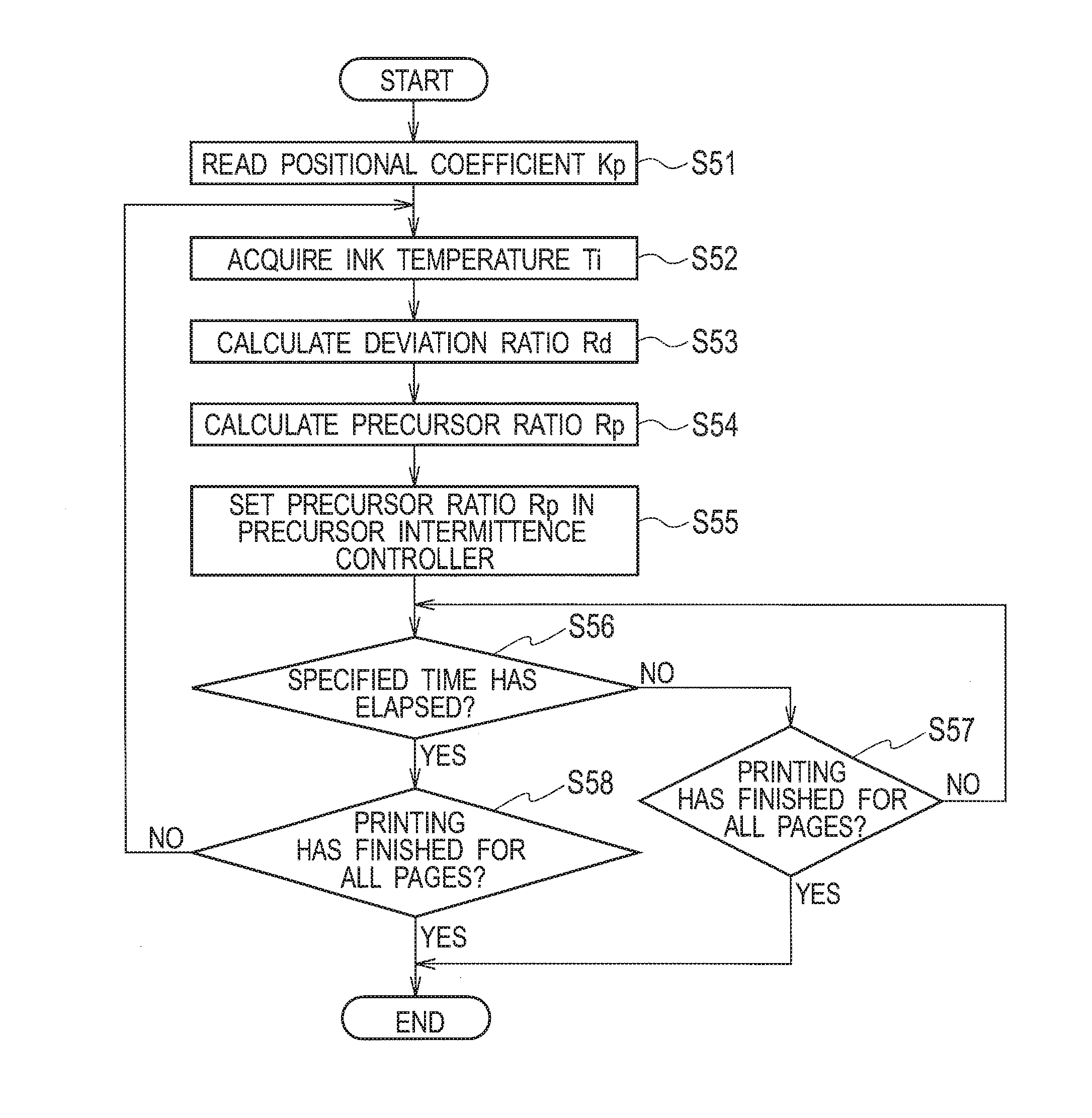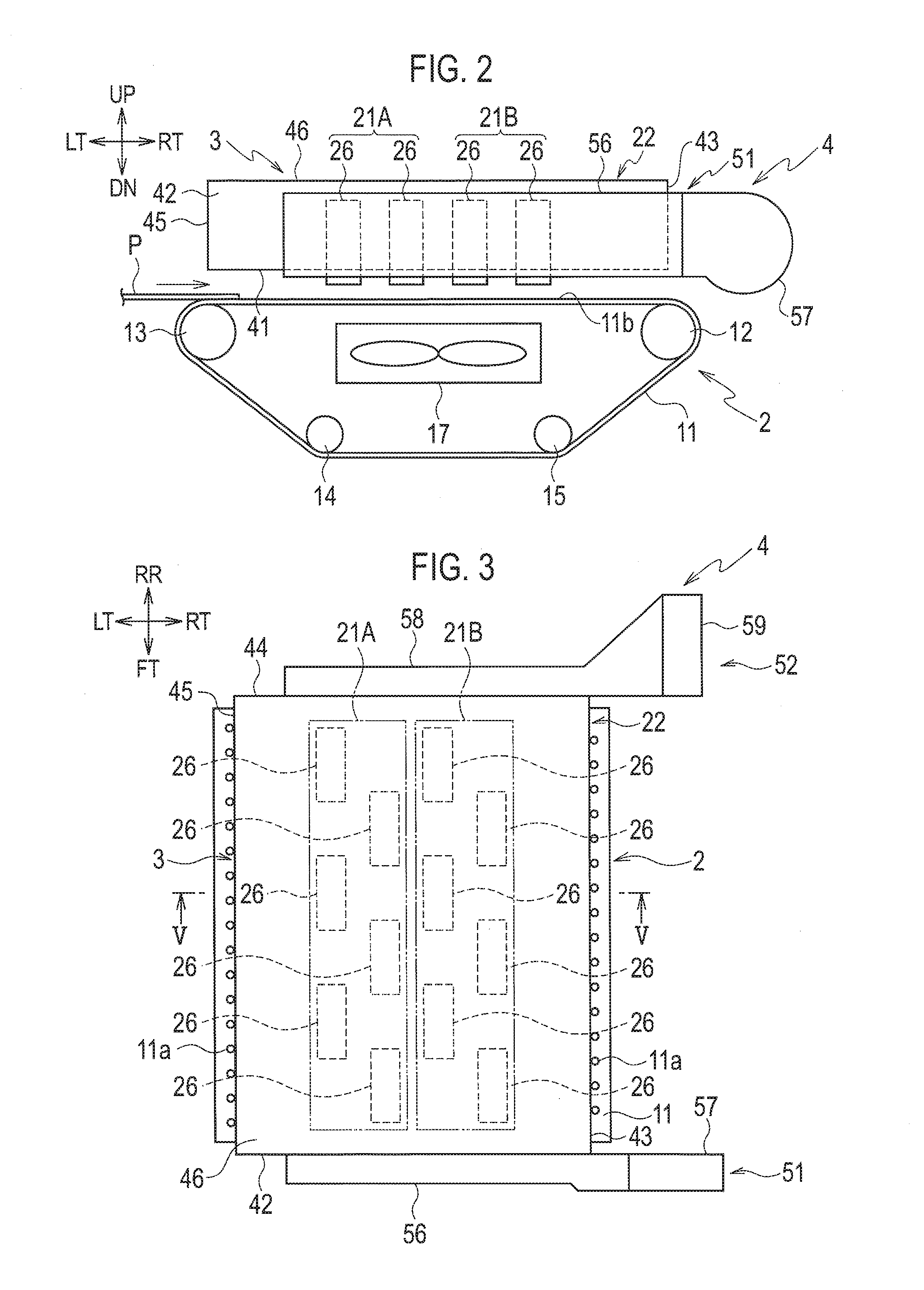Inkjet printer
- Summary
- Abstract
- Description
- Claims
- Application Information
AI Technical Summary
Benefits of technology
Problems solved by technology
Method used
Image
Examples
first embodiment
[0052]FIG. 1 is a block diagram illustrating the configuration of an inkjet printer 1 according to a first embodiment. FIG. 2 is a schematic configuration diagram of a conveyer 2, a head unit 3, and a head cooler 4 of the inkjet printer 1, which is illustrated in FIG. 1. FIG. 3 is a plan view of the conveyer 2, the head unit 3, and the head cooler 4. FIG. 4 is an exploded perspective view of the head unit 3 and the head cooler 4. FIG. 5 is a partially-enlarged cross-sectional view of the conveyer 2 and the head unit 3 taken along line V-V in FIG. 3. FIG. 6 is a partial cross-sectional view of an inkjet head. 26 taken along a horizontal plane. FIG. 7 is a schematic configuration diagram of an ink circulator 6 (6A, 6B), an ink feeder 7 (7A, 7B), and a pressure generator 8 of the inkjet printer 1, which is illustrated in FIG. 1. FIG. 8 is a block diagram illustrating the configuration of a controller 9 of the inkjet printer 1, which is illustrated in FIG. 1. FIG. 9 is a block diagram i...
second embodiment
[0222]Next, description will be given of a second embodiment which involves a change in the precursor-ratio setting process in the embodiment described above.
[0223]In the second embodiment, an image processor 122 is configured to calculate a print coverage rate Ra for each inkjet head 26 page by page based on image data.
[0224]A CPU 151 of an actuator controller 124 is configured to calculate a precursor ratio Rp by using the print coverage rate Ra in a precursor-ratio setting process. FIG. 21 is a flowchart of the precursor-ratio setting process in the second embodiment.
[0225]In Step S41 in FIG. 21, the CPU 151 reads a positional coefficient Kp of each inkjet head 26 from a ROM 152.
[0226]Then, in Step S42, the CPU 151 reads the print coverage rate Ra of each inkjet head 26 from the image processor 122.
[0227]Then, Step S43, the CPU 151 calculates the precursor ratio Rp. In the second embodiment, the precursor ratio Rp is calculated from Equation (3) below.
Rp(%)=Kp=(100−Ra) (3)
[0228...
third embodiment
[0232]Next, description will be given of a third embodiment which involves a change in the precursor-ratio setting process in the embodiments described above.
[0233]FIG. 23 is a flowchart of a precursor-ratio setting process in the third embodiment.
[0234]In Step S51 in FIG. 23, a CPU 151 of an actuator controller 124 reads a positional coefficient Kp of each inkjet head 26 from a ROM 152.
[0235]Then, in Step S52, the CPU 151 acquires an ink temperature Ti at the inkjet head 26 from its head-ink temperature sensor 68.
[0236]Then, in Step S53, the CPU 151 calculates a deviation ratio Rd of the ink temperature Ti from a reference temperature Tk. The deviation ratio Rd is calculated from Equation (4) below.
Rd(%)=((Tk−Ti) / Tk)×100 (4)
[0237]Then, in Step S54, the CPU 151 calculates a precursor ratio Rp. In the third embodiment, the precursor ratio Rp is calculated from Equation (5) below.
Rp(%)=Kp×Rd (5)
[0238]As a result, as illustrated in FIG. 24, the precursor ratio Rp corresponding to t...
PUM
 Login to View More
Login to View More Abstract
Description
Claims
Application Information
 Login to View More
Login to View More - R&D
- Intellectual Property
- Life Sciences
- Materials
- Tech Scout
- Unparalleled Data Quality
- Higher Quality Content
- 60% Fewer Hallucinations
Browse by: Latest US Patents, China's latest patents, Technical Efficacy Thesaurus, Application Domain, Technology Topic, Popular Technical Reports.
© 2025 PatSnap. All rights reserved.Legal|Privacy policy|Modern Slavery Act Transparency Statement|Sitemap|About US| Contact US: help@patsnap.com



